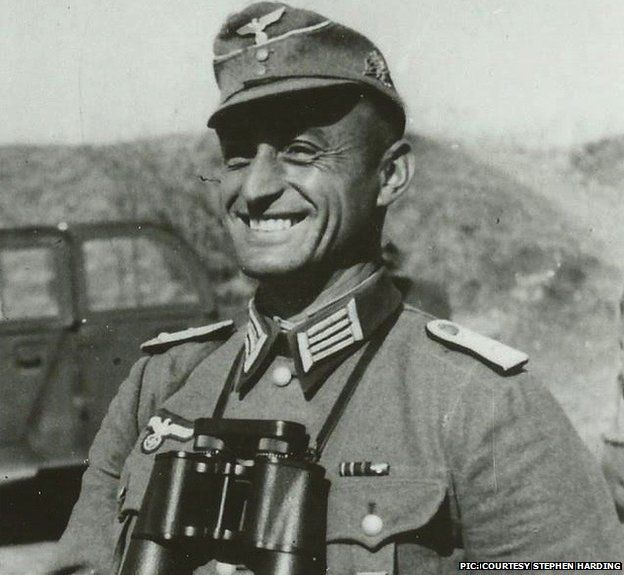 (Castle Itter)
(Castle Itter)
Seventy five years ago on this date, May 5, 1945, the U.S. Army fought one of the strangest battles of World War Two in which Americans, regular German army soldiers, and French prisoners of war fought German SS troops.
(French Prime Minister Paul Reynaud and General Maurice Gamelin at Castle Itter, beginning of May 1945 - damage to roof caused by Allied aerial bombing)
 The location was Itter, a village of 500 inhabitants nestled in the
Austrian mountains only a few miles from the German border and home to a castle built in the 13th century and in more recent times used as a residence and hotel. On February 7, 1943 the German SS take over control of the castle and by April 25 made it operational as a prison for high-profile captives. Most of the high value captives interned at Castle Itter for the next two years were French including:
The location was Itter, a village of 500 inhabitants nestled in the
Austrian mountains only a few miles from the German border and home to a castle built in the 13th century and in more recent times used as a residence and hotel. On February 7, 1943 the German SS take over control of the castle and by April 25 made it operational as a prison for high-profile captives. Most of the high value captives interned at Castle Itter for the next two years were French including:Former Prime Ministers Eduoard Daladier and Paul Reynaud. Reynaud was accompanied by his young mistress, Christiane Mabire.Also housed in the castle and performing many of the day to day support operations were Eastern European prisoners who had been transferred from Dachau.
Chief Generals of the Army Maxime Weygand and Maurice Gamelin.
Right-wing political leader Francois de La Roque.
Left-wing labor leader Leon Jouhaux
Marie-Agnes Cailliaux, the sister of Free French leader Charles de Gaulle.
Michel Clemenceaux, the son of WWI Prime Minister George Clemenceaux.
The prisoners were treated fairly well, sleeping in converted hotel guest rooms and having access to the castle's library, leaving them time to pursue their rivalries and begin work on contending memoirs. Daladier, prime minister from 1938 (when he supported Chamberlain in the Munich Agreement) through the start of the war, resigning in March 1940 was a fierce rival of Reynaud, who succeeded him, before resigning on June 16, 1940 because of his refusal to enter into an armistice with Germany. Gamelin had been army chief at the start of the war and Daladier had been his dedicated supporter. His disastrous performance during the initial phase of the German invasion in May 1940 forced his removal and replacement with his bitter rival General Weygand. Reynaud refused to shake hands or speak with Weygand while both were imprisoned.
Commandant of the prison was SS Captain Sebastian Wimmer, with whom many of the French prisoners established a decent relationship. By later April, able to monitor by radio the Allied advance into Germany, Daladier and Reynaud, concerned that the prisoners would be massacred before the Allies freed them, met with Wimmer, who assured them he would do all in his power to keep them safe.
On April 30, the Commandant of Dachau, Lt Col, Eduoard Walter appeared at the castle and after a tumultuous couple of days committed suicide there on May 2. Two days later, Wimmer and his men abandoned the castle.
The day before Daladier and Reynaud persuaded a Croatian prisoner, Zvonimir Cuckovic, who worked as electrician, janitor and handyman at the castle to take a message to the advancing Americans. Wimmer used Cuckovic to run errands outside the castle and when asked to do so again on the 3rd, Cuckovic left and made straight for the advancing Allies, talking his way past two SS roadblocks. He made contact with the 103rd Infantry Division near Innsbruck, which began to muster a force to reach the castle.
In the meantime, two Wehrmacht officers, who had long since become disaffected with the German war effort, appeared on the scene. Captain Kurt-Siegfried Schrader (a Waffen-SS member) had become a member of the Austrian Resistance while Major Josef "Sepp" Gangl and about 30 of his soldiers were also in the area and became aware of the plight of the prisoners.
On May 4, Gangl and some of his men set out to find the Americans, finally locating Captain John C Lee Jr, B Company, 23rd Tank Battalion, 12th Armored Division. Initially skeptical, Lee, a native of Norwich, NY and recipient of a Bronze Star, was eventually convinced that Gangl was sincere and set off with Gangl to do a recon to the castle. Allowing Gangl's Germans to retain their arms, Lee met with Daladier and Reynaud and promised to return with reinforcements to protect the prisoners.
Captain Jack Lee

Later that day, Lee set out with several tanks and some infantry. After several tanks crossed a bridge, the last one caused the bridge to collapse blocking most of the infantry who were at the rear of the column. Lee pressed on with the tank, reaching the castle, and received infantry support from Wehrmacht troops led by Schrader and Gangl. It was just in time.
At 4am on the morning of May 5, the castle came under assault from about 150 soldiers of the 17th SS Panzergrenadier Division. The fighting was fierce and, tragically, Gangl was killed as described here:
Soon Castle Itter was being struck by a barrage of 20mm and 88mm rounds. One of the first casualties was Besotten Jenny. The M4 Sherman was struck by two anti-tank rounds and turned into a fiery wreck. While the crew was able to escape, Captain Lee’s precious tank was gone. While this was occurring the French VIP’s had disregarded Lee’s orders and were out and about roaming the castle, enjoying the beautiful morning despite the battle raging around them. Many of the former prisoners felt they could not stand idly by while Allied troops were fighting desperately to hold off the enemy. According to Paul Reynaud;Twelve hours after it started additional American troops reached the castle and the SS soldiers either withdrew or surrendered. Major Gangl was the only fatality among the defenders.
“I soon saw that, as the tank was burning, the attackers could penetrate from the other side into the courtyard by the bridge which linked up with the flank of the mountain. I dodged into the castle. I got my tommy-gun out of my trunk and went down to the courtyard, where I found some soldiers. Clemenceau had already calmly posted himself at a loophole in case the attackers wished to take possession of the tank. I… took up a position near to him”.
Reynaud, Gamelin, Clemenceau, de La Rocque, and Borotra emerged armed with weapons to take up defenses around the castle. The elderly Reynaud moved towards the gatehouse eager to fight the enemy, but Major Gangl rushed down to move the former Prime Minister to a safer position. As he ran across the courtyard, Gangl suddenly fell to the ground. His body limp and blood pouring from around his head. Captain’s Lee and Schrader were stunned when they heard that Major Josef Gangl was dead. He was struck in the head by a sniper’s bullet that killed him instantly. Sadly there was no time to mourn the loss of their friend, as enemy small arms fire was intensifying with each passing moment.
Major Sepp Gangl

 (Marie-Agnes Cailliaux)
(Marie-Agnes Cailliaux) After the war:
Daladier and Reynaud returned to playing prominent roles in French politics.
Five days after being freed from German captivity, General Weygand was arrested by the Free French and charged with collaborating with the Vichy government. He was acquitted after a trial in 1948.
Leon Jouhaux broke with the communists after the war, helped found the International Labor Organization and was awarded the Nobel Peace Prize in 1951.
Major Gangl is regarded as a national hero in Austria.
As a former Waffen-SS officer, Captain Schrader was held as a prisoner by the Allies for two years before being cleared, in part, because of his actions at Castle Itter.
John Lee received a Silver Star for his initiative and bravery in defending Castle Itter. He had difficulty adjusting to post-war life and died in 1973 at the age of 54.
No comments:
Post a Comment